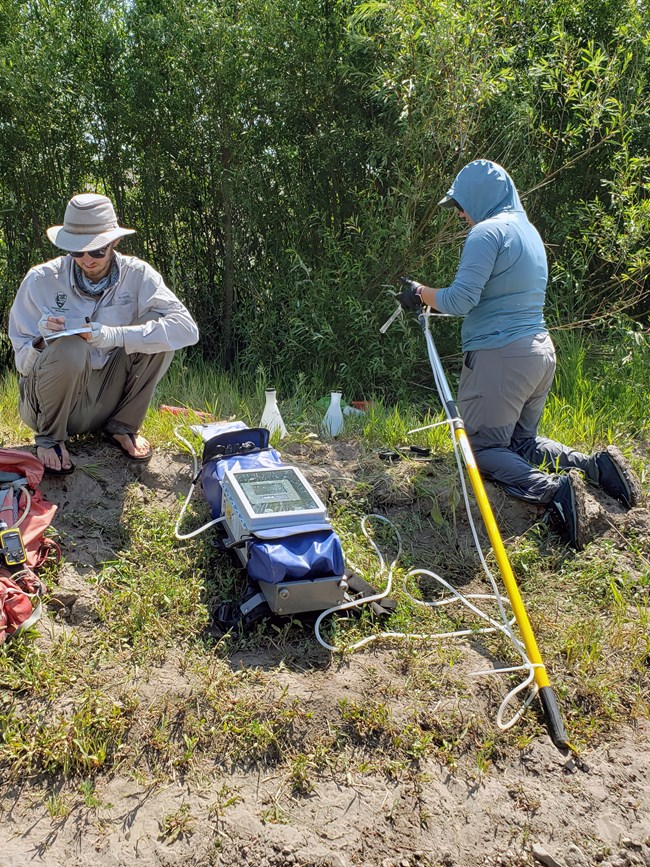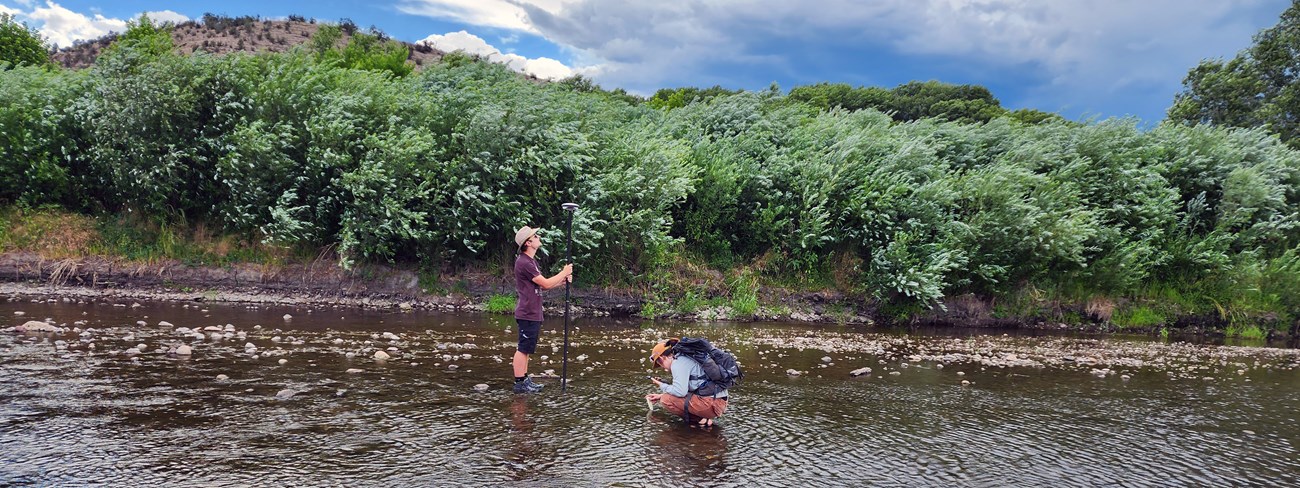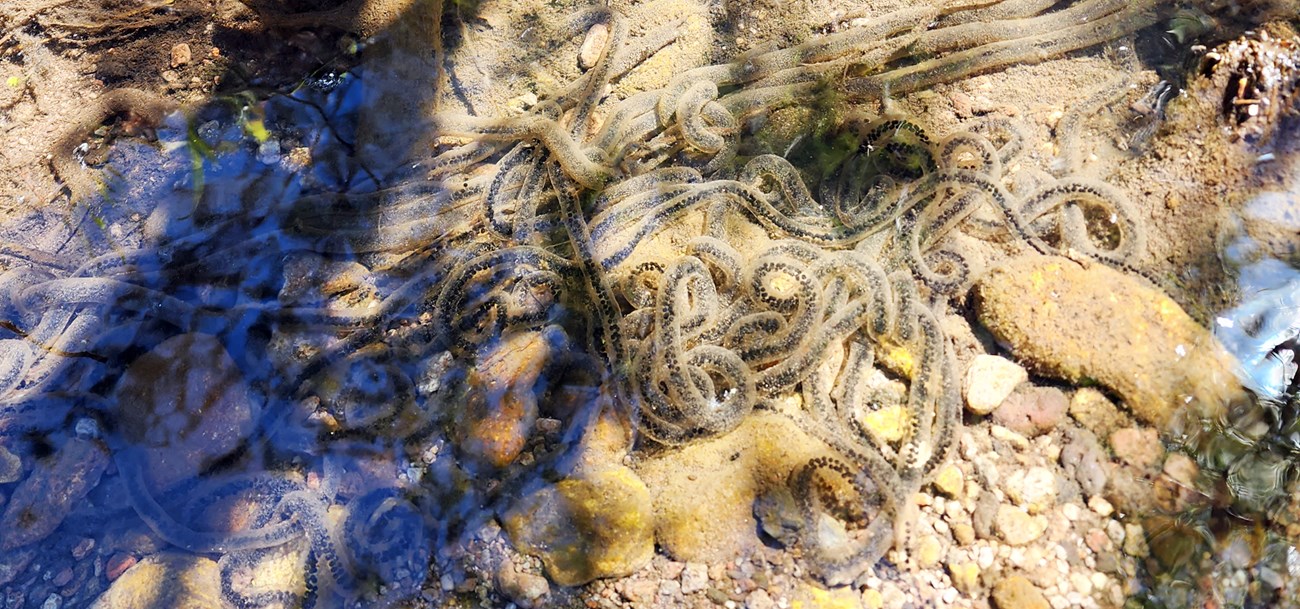Last updated: July 24, 2024
Article
Project Page: Amphibian and Garter Snake Recovery in Southwestern Parks

NPS/E. SCHNAUBELT

NPS/TANI HUBBARD
The Threat
Globally, amphibians and aquatic reptiles are among the most threatened taxa on earth due to the compounding effects of climate change, water extraction, invasive species, and habitat decline. In the Southwest, a primary threat is the invasive American bullfrog (Lithobates catesbeianus)—a voracious, nonnative predator called the “Great White Shark of the Southwest.” Bullfrogs also carry chytrid fungus and ranavirus, diseases that are linked with population declines in many native aquatic species including threatened and endangered species.
To restore and protect aquatic animals, it is important to know the distribution and abundance of native aquatic animals, bullfrogs, and diseases. The Southwest Network Collaboration is implementing a project to collect this information and address these conservation issues. The project has three main goals:
- Effective American bullfrog control.
- Native species recovery and reintroduction.
- Development of an Early Detection/Rapid Response Protocol for American bullfrogs.
To meet these goals, we will implement this project in perennial springs, rivers, and wetland ecosystems in eight parks (Figure 1). This project will help us restore native wetlands, support state and federally listed threatened and endangered species, and control invasive species in national parks.

NPS
Actions
The American bullfrog is abundant in Tuzigoot National Monument and Gila Cliff Dwellings National Monument, so bullfrog control will be a priority before recovery and native species reintroduction actions can occur.
Saguaro National Park and Montezuma Castle National Monument have some American bullfrogs that will require control—they are in the watershed and occasionally appear in the park. Recovery and native species reintroduction actions will occur relatively soon in these two parks.
The remaining parks historically had bullfrogs, but they have not been detected recently. These parks are ready for native species reintroduction and implementation of the Early Detection/Rapid Response Protocol for bullfrogs: Coronado National Memorial, Chiricahua National Monument, Fort Bowie National Historic Site, Carlsbad Caverns National Park.

NPS
Monitoring to Evaluate Our Actions
We will conduct long-term monitoring of aquatic animals and aquatic habitats (including water quality and chemistry) to understand both the current condition of aquatic systems and how they may be changing over time. This will allow us to evaluate the effectiveness of the recovery and reintroduction actions and our bullfrog control efforts. Knowing if we are meeting our goals along the way helps us adapt our management actions to ensure success. To keep restored sites unimpaired, we will be developing an early detection and rapid response system to keep bullfrogs from reinvading.
In addition to traditional visual encounter surveys for aquatic animals, we will implement new acoustic monitoring and environmental DNA (eDNA) sampling technologies. Animals leave DNA behind when they shed skin cells, feces, hair, and reproductive secretions into the environment. Sampling for eDNA in the soil, water, and air has great potential for passively monitoring rare, elucive, and hard-to-spot species in a cost-effective and wide-spread manner. We will also be monitoring for diseases like ranavirus and chytrid fungus using eDNA sampling.
There are two sampling methods for eDNA depending on the water feature. In tinajas and springs, field technicians collect water samples and hand-pump the water through fine filters. In rivers and larger bodies of water, field technicians use an eDNA backpack sampler to collect water. Immediately after either method of sampling, the filters are collected and preserved in vials of ethanol. As soon as possible the filters are then sent to our partner Dr. Caren Goldberg at Washington State University. In her lab she utilizes quantitative PCR to compare the DNA found in the samples to an online database and reports whether our target species are detected in the sample.

NPS

NPS
Target Species for eDNA Sampling
Native aquatic animals:
Lowland leopard frog (Rana yavapaiensis): a native species of management concern due to its regional decline
Chiricahua leopard frog (Rana chiricahuensis): a native threatened species.
Mexican gartersnake (Thamnophis eques megalops): a native threatened species
Other native frogs, toads, and aquatic garter snakes
Invasive animals:
American bullfrog (Lithobates catesbeianus): a nonnative, invasive predator and a threat to native amphibians
Diseases:
Ranavirus (Family - Iridoviridae; Genus - Ranavirus): a group of double-stranded DNA viruses impacting frogs globally. It is effectively impossible to remove ranaviruses from a watershed once introduced.
Chytrid fungus (Batrachochytrium dendrobatidis): a fungal pathogen that is rapidly spreading globally and an infectious threat to native amphibians.

NPS/ANDY HUBBARD
Partners
This ambitious project builds on considerable existing work by the University of Arizona and our previous baseline biological inventories and monitoring data.
Our partners will be vital to the success of this project:
- Tucson Audubon Society
- Arizona Frog Team (University of Arizona)
- Arizona Game and Fish Department
- New Mexico Department of Game and Fish
- US Fish and Wildlife Service
- US Geological Survey
- Washington State University
- Park neighbors
For More Information
Contact Andy Hubbard, Program ManagerSonoran Desert Network Inventory and Monitoring Program
National Park Service
Tags
- carlsbad caverns national park
- chiricahua national monument
- coronado national memorial
- fort bowie national historic site
- gila cliff dwellings national monument
- montezuma castle national monument
- saguaro national park
- tuzigoot national monument
- southwest network collaboration
- sonoran desert network
- sodn
- chihuahuan desert network
- chdn
- southern plains network
- aquatic animals
- aquatic ecosystems
- american bullfrogs
- bullfrogs
- invasive species
- threatened species
- endangered species
- edna
- amphibians
- reptiles
- amphibians & reptiles
- american southwest
- arizona
- new mexico
- inflation reduction act
- reintroduction
- chytrid fungus
- ranavirus
- chiricahua leopard frog
- lowland leopard frog
- arizona toad
- mexican garter snake
- acoustic monitoring
- monitoring
- edna monitoring
- water monitoring
- amphibian monitoring
- reptile monitoring
- streams
- springs
- inventory and monitoring division
Success
Thank you. Your feedback has been received.
Error
alert message







